Soil testing procedures need to be continually evaluated. For example, there have been increases in soil pH for most land used for 30 to 40 years in Florida agricultural production. The increase in pH is due to routine liming practices and to irrigation with high-pH well water from limestone aquifers, such as the Florida aquifer. Free lime in the soil sample could render an extractant incapable of performing its function on today's soils, so a new soil testing procedure may be needed.
This publication describes the process of developing a predictive and/or diagnostic soil test that (1) can be depended on by commercial agricultural and horticultural producers as well as homeowners and (2) can provide accurate nutrient recommendations or diagnose nutrient imbalances for crops or plants. This publication provides information on soil testing for county UF/IFAS Extension agents to use in their educational programs for commercial agriculture and urban landscapes. An understanding of soil testing is an important part of preventing excess fertilizer applications that can potentially impact the environment and ensuring commercially viable yields and aesthetic, healthy landscapes. Though soil-testing research is not widely conducted today in the United States, it is still important to understand the research process and to learn about how our modern soil tests were developed. Furthermore, it is important to understand proper soil testing, so we can teach farmers and landscapers (professional and private) to ask important questions about the soil tests that they are using or planning to use in the future.
Soil tests serve as the basis for any lime or fertilizer recommendations for growing plants, and they are a simple, economical scientific tool. Essentially, soil tests are chemical tests performed on a soil sample to determine the soil's nutrient-supplying capacity for the particular crop/plant during that growing season. The laboratory result of a soil test is also referred to as a soil test index, because a soil test report is an integration of multiple values (such as values of nutrients and soil factors) associated with plant nutrient availability. We explain soil testing and its usefulness in EDIS document SS621, Soil Testing for Plant-Available Nutrients—What Is It and Why Do We Use It? (Hochmuth et al. 2014).
The soil test must be able to identify those soils for which fertilization will result in a return on investment (i.e., improvement/enhancement in yield and/or quality). In addition, the soil test must be able to identify those soils for which fertilization is NOT required. This part of the soil-test development is called correlation. A properly correlated soil test will identify soils where crops will respond to nutrient application(s) and those that will not. Further, the soil testing process must provide an accurate prediction of the fertilizer requirements for those soils deemed likely to respond. This part of soil test development is called calibration. A calibrated soil test can recommend a specific nutrient amount that corresponds to that specific soil-test value (index).
When we refer to a correlated-and-calibrated soil test, we are really referring to the soil-test-extractant method. Correlation and calibration are described in more detail in the following sections, along with some examples of data.
Unfortunately, correlation and calibration research is time-consuming and rather expensive. Most of the soil tests used throughout the country were developed between the 1950s and 1970s. In Florida, recent soil test development research occurred in late 1990s, when verification of nutrient recommendations for vegetables was completed.
Correlation
Soil test correlation is defined as the "process of determining the relationship between plant nutrient uptake or yield and the amount of nutrient extracted by a particular soil test method" (Mitchell and Mylavarapu 2014).
Correlation describes how two variables relate to each other. In soil testing, high values of one variable (the soil test index) are associated with high values of the other variable (crop yield). A correlated soil test will predict poor crop growth or yield, or will predict poor color of a landscape plant when the plant is grown in a soil with a low soil-test index (low nutrient availability). On the other hand, a correlated soil test will predict a higher yield or improved growth when landscape plants are grown in soil higher in availability of nutrient(s).
In the development of the soil test, the first set of experiments for researchers to conduct will address the issue of correlation. Correlation research may be initially carried out in a greenhouse using containers of the soil that differ in extractable nutrient content as determined by the soil-test extractant that is to be correlated. Several soils may be used and several extractants may be tested. Various crop species will be grown and crop responses measured (yield, nutrient uptake, or other physiological parameters). The researcher will look for crop responses that demonstrate low nutrient uptake and poor growth when the soil test index is low, and high nutrient uptake and greater crop growth when the soil test index is high.
Correlation is a relationship that can be tested statistically. In Figure 1, extractant 1 would be a highly correlated extractant, because plant nutrient uptake increased along with an increase in the extractable nutrient and the association between nutrient uptake and extractable nutrient is close. Extractant 2, however, is not well correlated, because there is considerable variation in plant uptake with extractable nutrient and the relationship is not as close as with extractant 1.
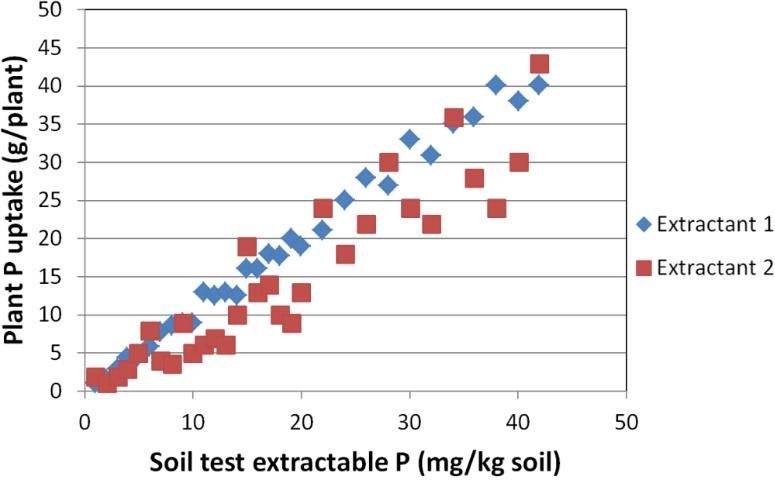
Credit: Hochmuth, Mylavarapu, and Hanlon
Greenhouse studies are good for conducting preliminary research, especially if several extractants are being compared and several soils are being used. However, field studies are required to confirm the development and selection of a soil test procedure.
After the extractant is selected from preliminary nutrient uptake studies, the researcher may use the extractant to evaluate crop response in the field. The researcher can partition the response curve, as in Figure 2, into several groups, corresponding with low, medium, and high indexes. (Some soil testing labs add very low and very high categories.) The low and medium areas on the response curve represent soils that would likely respond to additions of fertilizer, while the high soils would not.
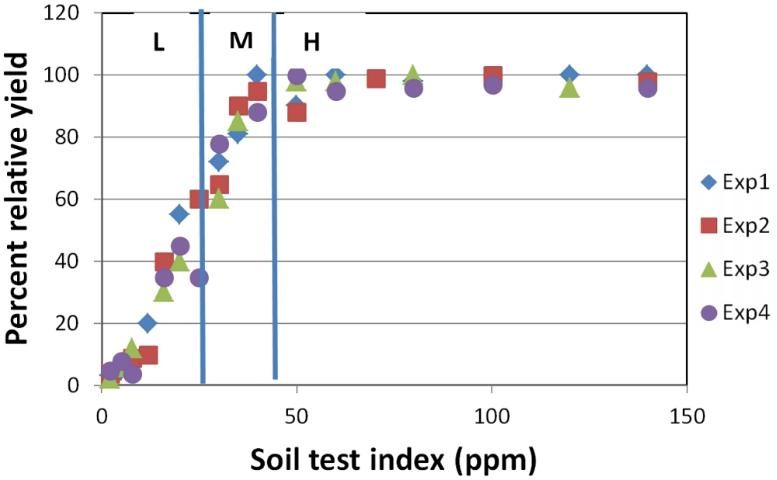
Credit: Hochmuth, Mylavarapu, and Hanlon
Calibration
Soil test calibration is defined as the "process of determining the crop nutrient requirement at different soil test values" (Mitchell and Mylavarapu 2014).
After a soil test (extractant) has been selected because of its high correlation with nutrient uptake and crop growth response, then experiments are set up to address the question, "How much fertilizer is needed for a specific soil test index?" This phase of the research is called "calibration" and consists of studies that test crop yield and nutrient uptake, and that may produce quality responses to the added fertilizer. These studies are best conducted in the field, since the yield results will better relate to "real world" farming or landscape practices. This research determines the relative portion of the total crop nutrient requirement that can be supplied from the nutrient reserve in the soil. The researcher hopes to locate fields with different extractable nutrient levels. It can be challenging to find locations with different soil-test index values. For example, finding a farm with low-phosphorus soil may be difficult, because farmers have already added fertilizer to any "low-P" soils. Sometimes researchers develop the requisite soils by starting with a low-nutrient soil and then adding various amounts of a nutrient to selected plots to generate the needed range in soil test indexes.
This part of the research takes considerable time, because the researcher needs to test the crop response in several locations throughout the agricultural area and across as many crops and soil types as possible. Crop production takes time, and weather variation and challenges are likely. This variability may be a large reason why such a small amount of soil-test calibration research is being conducted today, even though our currently used extractants were developed decades ago.
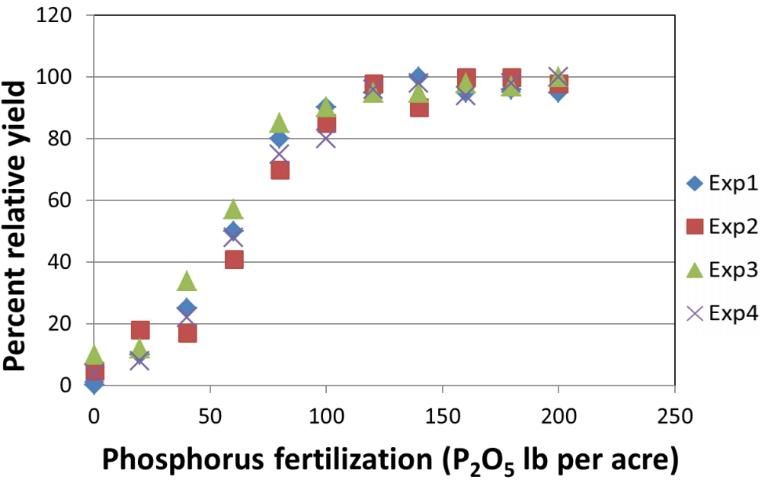
Credit: Hochmuth, Mylavarapu, and Hanlon
Examples of calibration studies with P are illustrated in Figures 3 through 5. With a soil that tests low or very low in a nutrient content, we would expect a dramatic crop response to added fertilizer (Figure 3). In this example, four experiments were conducted. Yield was maximized after 150 lb of P2O5 per acre were applied to this low-P soil. With enough experiments, the researcher may develop confidence in recommending 150 lb of P2O5 per acre with a low index. Yield response was not as dramatic with the soil testing medium in extractable P (Figure 4). On these medium testing soils, a fertilizer recommendation may be 80 lb of P2O5 per acre. On soils testing high or very high in P, there will be no crop response to added fertilizer (Figure 5). For these soils, no P fertilizer recommendation is made, because these soils can supply all the P needed for the crop that season. If our soil test extractant is calibrated (having been field-tested), then farmers can depend on the "zero-fertilizer" recommendation.
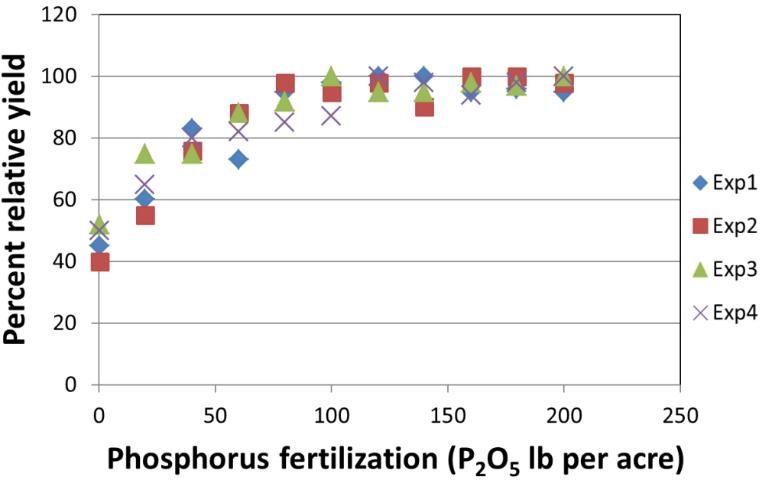
Credit: Hochmuth, Mylavarapu, and Hanlon
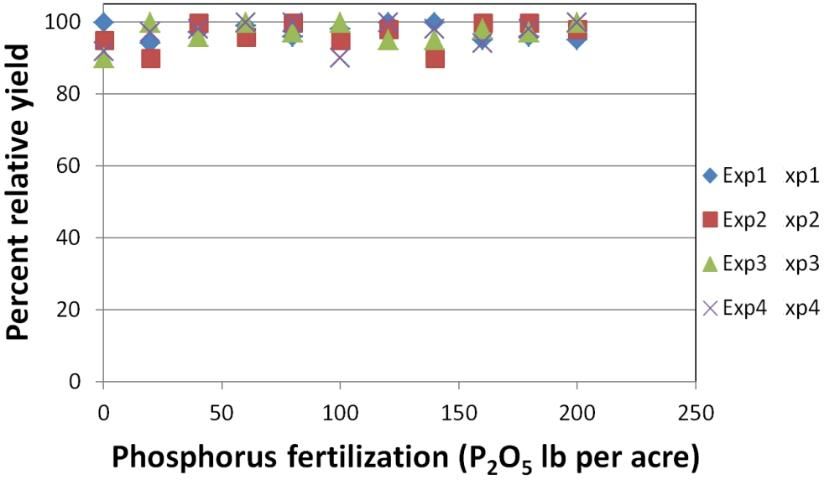
Credit: Hochmuth, Mylavarapu, and Hanlon
Fertilizer-response studies involve statistical analysis of the data so that the observed crop responses can be related to the variation in rates of nutrient applied, not to random variation (Peck et al. 1977). This statistical analysis can also involve the use of modeling of the responses. The goal of involving statistics and proper experimental design is to pick the best rate of fertilizer to be matched with the particular soil test index. In today's economically and environmentally conscientious world, there is little room for underpredicting or overpredicting fertilizer rates. More information is presented on this issue of fertilizer rate research and data analyses and interpretation in the EDIS document SS548, Fertilizer Experimentation, Data Analyses, and Interpretation for Developing Fertilizer Recommendations—Examples with Vegetable Crop Research (https://edis.ifas.ufl.edu/ss548).
Some laboratories use the "stair-step" approach to making fertilizer recommendations. This approach is used by the University of Florida whereby a group of soil test indexes—for example, 0 to 25—will receive the same fertilizer recommendation. Some labs use a regression approach and associate a decreasing fertilizer amount with each increasing soil-test index value. The regression approach requires a significant amount of data to confidently develop the regression model that associates a fertilizer recommendation so closely with the soil test index.
Ideally, calibration research would include the use of accepted fertilizer management practices so that the observed responses to the nutrient in question are actually due to the nutrient amounts. For example, fertilizer placement and timing of application in the crop production system would be selected to minimize chances of loss of nutrients to leaching or runoff.
Conclusion
Considerable research goes into developing a useful soil test extractant. The developmental process involves careful correlation and calibration experimentation. Soil testing is now considered a best management practice to avoid over-fertilization and associated inefficiencies in nutrient utilization by crops. Calibrated soil testing helps farmers maximize profits and protect the environment.
Other Publications in this Series on Soil Testing
Hochmuth, George, Rao Mylavarapu, and Ed Hanlon. 2014. Soil Testing for Plant-Available Nutrients—What Is It and Why Do We Use It? Gainesville: University of Florida Institute of Food and Agricultural Sciences. https://edis.ifas.ufl.edu/ss621.
Hochmuth, George, Rao Mylavarapu, and Ed Hanlon. 2014. Fertilizer Recommendation Philosophies. Gainesville: University of Florida Institute of Food and Agricultural Sciences. https://edis.ifas.ufl.edu/ss623.
Hochmuth, George, Rao Mylavarapu, and Ed Hanlon. 2014. The Four Rs of Fertilizer Management. Gainesville: University of Florida Institute of Food and Agricultural Sciences. https://edis.ifas.ufl.edu/ss624.
References
Peck, T. R., J. T. Cope, and D. A. Whitney (eds.). 1977. Soil testing: Correlating and interpreting the analytical results. Amer. Soc. Agron. Special Publ. No. 29. Amer. Soc. Agron., Madison, WI.
Mitchell, C. C. and Mylavarapu, R. 2014. "Soil Test Correlation and Calibration for Recommendations." Soil Test Methods from the Southeastern United States. Southern Cooperative Series Bulletin No. 419. USDA-SERA-IEG-6. ISBN 1-58161-419-5. https://aesl.ces.uga.edu/sera6/PUB/MethodsManualFinalSERA6.pdf.
Mylavarapu, R. S. 2009. "Diagnostic nutrient testing." Hort Technology 20: 19–22.